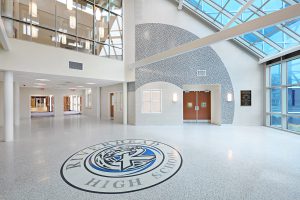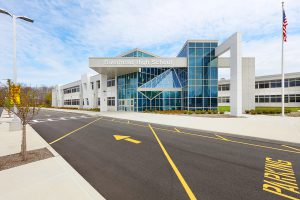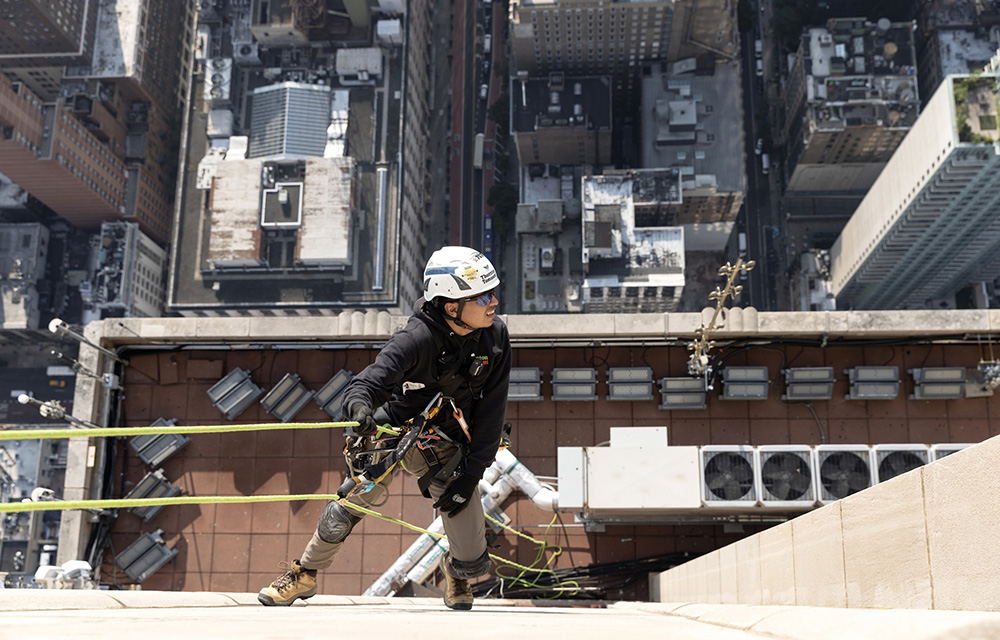BBS completes $32.6 million expansion and renovation of Riverhead High School
Riverhead, NY BBS Architects, Landscape Architects and Engineers has completed the expansion and renovation of Riverhead High School. The project was part of the BBS-designed $78.3 million bond issue-financed expansion, renovation, and infrastructure improvement program at the Riverhead Central School District (CSD). Building Design & Construction ranks BBS as the 42nd largest K-12 education architect and the 73rd largest architecture/engineering design firm in the U.S.
BBS principal Roger Smith, AIA, LEED AP, said, “At $32.6 million, the expansion and renovation of Riverhead High School was the largest part of the district’s capital program.” Nearly half of this budget was spent renovating and updating existing spaces and building systems.
Riverhead High School is the flagship of the district, and has been planned and re-designed to reflect the resurgence of the Riverhead community as a hub of growth and activity on Eastern Long Island. Riverhead is located at the intersection of the North and South Forks of L.I., and is in many ways the “gateway” to the Hamptons and the North Fork Wine Region. The school district’s buildings had begun to age and were in need of attention. The goal was to refocus community attention on bringing back the school district’s facilities up to current standards so as to once again be a central feature of positive community identity.
The school received a 35,000 s/f, two-story addition, which houses a new main entry, four 1,400 s/f advanced science classrooms, four 825 s/f science classrooms, and the main, guidance, and administrative offices. A smaller, second addition of 2,232 s/f houses a physical education station, including a new weight training room. In the original high school building, the work included the replacement of the roof and all windows, and renovations to the 5,600 s/f library, 2,756 s/f auditorium, two music rooms, three special education rooms, health and home economics rooms, 11 science and chemistry classrooms, large group instruction room, cafeteria, 1,347 s/f art room, home and careers room, ROTC office, and bathrooms.
Designing K-12 schools for an existing community can be as simple as taking the students’ needs into consideration and building a structure that reflects those needs. However, BBS has developed an approach that goes much further, designing schools in ways that reflect the needs of the greater community and, as a result, the school changes the entire community, not just the students within, for the better.
In other words, the school is not a standalone structure but rather, it becomes the epicenter of the community, galvanizing people of all ages. In essence, it bridges the gap between old and new, past and future, the students and the surrounding community.
“We named this the ‘Bridge’ planning and design approach – the term that encompasses bridging and addressing the varied needs of the community, not only by embracing the educational setting, but also redefining the sense of community itself by the new architectural presence. Our goal is to change the way education is delivered, change the way the environment looks, and the way the community sees it,” explained Smith. “When school districts and local residents work together, the possibilities are endless.”
Riverhead is a community in which the Bridge concept has proven successful. “By improving and expanding schools built between the 1930s and the 1960s, including the high school, we’ve created a visual and built environment that exemplifies perceivable growth and the benefits of community investment,” said Smith. “We’ve created a secondary downtown through a refocusing of the community to its major assets – the school system and structures themselves. This gives everyone a sense of pride, a sense of ownership, and a heightened sense of community. Our work with the Riverhead CSD has encouraged a continued holistic approach to community development. And, the beauty is that it is not all ‘newly invented,’ but rather is a collective expression and extension of the best qualities of the past and present for Riverhead’s future.”
The architectural identity of Riverhead High School has been developed to reinforce the sense of a “fresh start” in its use of materials and form. In contrast, but not at odds with the High School, the Roanoke Elementary School, built in 1929 has been renovated and expanded with an architectural identity relating to the original time period of the building itself, that was once the site of the first Riverhead Library.
This comparison expresses an important aspect of the “Bridge” concept for BBS; it is not about the “architect,” it is about the “community.” Maintaining, expanding, and embellishing the existing architectural fabric appropriately generates and maintains a sense of history, place, and forward development, all at the same time. In the end, the community’s history is maintained and then expanded, not eradicated, ignored, or simply re-invented for the sake of reinvention. Great care is taken to create contextually appropriate design responses specific to each building, group of buildings, and the community at large.
As a part of the design process, a group of about 50 community members formed a group called the Community Partnership for Revitalization (CPR). This group met for over a year, and was comprised of community leaders, community members, parents, school district officials, faculty, and design professionals. Great debates were had about all aspects of master planning, including the desire to follow sustainable design practices. In the end, every existing asset was to be preserved, maintained, and adapted for continued use moving forward.
The planning committee wanted to make sure that the building would have a completely transformed identity by the end of construction. The previous Riverhead High School building entry was somewhat “non-descript” by today’s standards, and hard to find. The new entry has been designed to be dynamic and welcoming, with intersecting frames and volumes symbolic of this community’s geographic position at the intersection of the North and South Forks of Long Island. The existing building window system was also completely replaced to match the new addition, providing both energy efficiency and creating new imagery for the entire structure.
All Riverhead High School building program elements were evaluated, including classrooms, science, art, music, P.E., library, and the main office. It was decided to fully use the existing building as an asset before adding to it, or taking away from it. The 35,000 s/f building addition only added new space required by the educational program that could not be physically achieved within the original building. The new main entry within the addition relocated the main office, guidance, and attendance areas. These previous administrative spaces within the existing building were then renovated to become classrooms. Approximately 45,000 s/f of existing space was reconfigured. In all, the expanded and renovated building is comprised of approximately 221,000 gross s/f for 1,540 high school students in grades 9-12.
The original building was constructed in the 1950s and therefore had physical limitations as per the educational design approach of that period, compared with 21st century learning. Existing science rooms have been expanded internally, while new Biology/Chemistry Lecture Labs have been placed in the new construction. A new weight room was also added; the new Band Room was placed in the space of the previous weight room. Major renovations also took place at the library, auditorium, cafeteria, art rooms, home and careers room, large group instruction room, music rooms, and restroom facilities.
The high school sits at the northern end of a campus of three buildings: Riverhead High School, Riverhead Middle School, and Pulaski St. School. The design of the overall site addresses the needs of each school both independently and collectively. A major design objective was to be sure that traffic patterns would promote student safety and enhance building security. Landscape buffers were included to mitigate hardscape areas with vegetation and shade. Specific improvements to the main campus include construction of a new, 1,200-seat home team bleacher, separate 250-seat visitor bleachers, running track resurfacing, tennis court repairs, and improvements to both the girls’ softball and boys’ baseball fields.
The Riverhead High School project has succeeded in creating a new image for the Riverhead community as one of its local structures that has been given a “fresh new start.” The surrounding area is bustling with activity and development, as it is one of the few areas left on Long Island with open acreage and new communities being constructed. This project’s success exemplifies the district’s vision of anticipating the future of its community and being prepared for even greater things to come. The community can “see” the change; the students and faculty are “experiencing” the change.
The Riverhead Central School District’s capital program began construction in 2012 and includes phased construction activities at eight sites. The program encompasses the district’s seven schools and shared main campus. BBS has served the district as architect, interior designer, construction administrator, and civil and MEP (mechanical, electrical, and plumbing) engineer for the entire program. The local community approved the bond financing for the capital program in a vote that took place in 2011. In addition to BBS, the design team included structural engineers Ysrael A. Seinuk, P.C. and Reilly Tarantino Engineering.
For nearly two decades prior to the beginning of the capital program in 2012, the land usage of the Riverhead area has been shifting from primarily agricultural to mainly residential, with accompanying commercial. This shift, accompanied by the housing boom of the early and mid 2000s, had resulted in an unforeseen acceleration of young families and their children moving into the area. Since that time, the Riverhead Central School District had been not only facing overcrowding issues, but also a simultaneously aging infrastructure with many of the schools’ facilities having been erected as early as the 1920s and 1930s.
The preservation of assets was a primary goal of the district’s community committee, as well as to eliminate all temporary portable classrooms, which had begun to populate the campuses as short-term solutions along the way to historically increasing student enrollment. It was time to take a holistic view of the entire district and come up with a comprehensive solution to all of the various challenges being faced.
The district retained BBS Architects & Engineers to review the needs and develop a program to address them. BBS performed a review of the existing facilities, analyzed demographic data and enrollment trends, assessed the cost of various alternatives, and gathered input from the district’s personnel and the local community. Based on this research, BBS developed the capital program that was divided into three distinctive areas:
1. Spatial needs, which encompassed the necessary additional classrooms, administrative offices, and other facilities.
2. Facility needs, which included the required maintenance and capital improvements to existing facilities and infrastructure.
3. Site work, which encompassed sports fields, playgrounds, pick-up and drop-off loops, driveways, and parking areas.
The final program included improvements to the district’s five elementary schools, middle school, and high school, as well as the shared main campus site. To minimize interruptions to the district’s educational operations and allow the schools to continue their regular instructional activities, the program was divided into three main phases with multiple steps in each phase.
“To address the large scope and multi-site nature of the project, BBS created individual building teams responsible for the architectural and engineering design at individual sites,” said BBS senior architecture associate Lawrence Salvesen, AIA, LEED AP. “These teams operate with BBS in-house support encompassing architecture, interior design, sustainability engineering, educational programming, landscape architecture, and civil, mechanical, plumbing, and electrical engineering. The individual teams provide the client with one point of responsibility for each project and together comprise the overall group dedicated to the entire Riverhead program.”
“Although the Riverhead schools will not pursue LEED certification, we have applied sustainable design principles into both new building construction and existing building reconstruction,” added BBS project designer Kevin Walsh, AIA, LEED AP. “These include over-insulated exterior building envelope components, such as roofing, wall assemblies, and windows; high-efficiency lighting and HVAC systems, water-saving fixtures, and the re-use of existing assets to reduce new footprint.”
Headquartered in Patchogue and established in 1975, BBS Architects, Landscape Architects and Engineers is a leading Long Island and NY/NJ/CT Tri-state Area designer of sustainable educational, commercial, institutional, public and athletic facilities. The firm designed the first LEED-certified public school in New York State – the Hampton Bays Middle School in Hampton Bays, NY – that received LEED Silver certification. Over the last decade, BBS has designed educational facilities valued at approximately $3 billion. The firm’s services include architecture, master planning, interior design and landscape architecture as well as civil, mechanical, electrical and plumbing engineering, and computer network design.
BBS’ current and recent work includes the new William J. Lindsay Life Sciences Building at the Suffolk County Community College Ammerman Campus in Selden, N.Y.; the newly renovated and expanded South Side High School in Rockville Centre, N.Y.; four expanded and renovated facilities at the Smithtown Library; outdoor Athletics Facilities at the Babylon Union Free School District; and an upcoming Alcoholism Research Center in Calverton, N.Y., currently in design
NYC mayor and DOB release comprehensive façade inspection and safety study conducted by Thornton Tomasetti











.gif)
.jpg)

.gif)